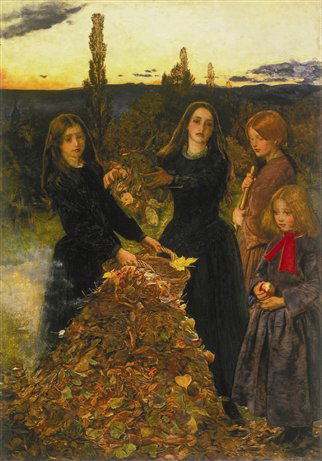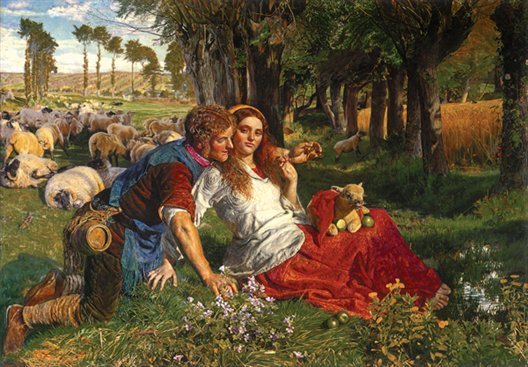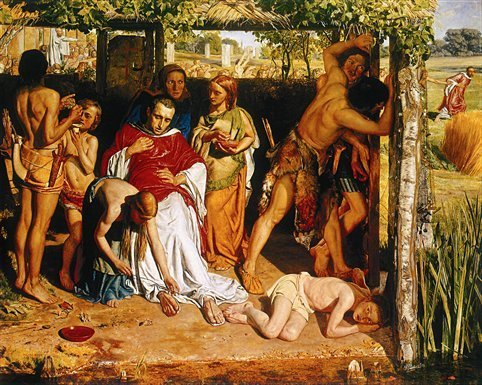The Bridesmaid, 1851.
Oil on panel, 27.9 x 20.3 cm.
The Fitzwilliam Museum, ridge.
II. The Definition and Results of
Pre-Raphaelitism
But who exactly was this victor? It is now time to ask the question, since the tournament is over and he has raised the visor behind which he fought. For “Pre-Raphaelitism” is a term that is more mysterious than explicative, and it should be discussed now that the battle has been won, in order to understand what it meant and what happened during the struggle to lead to its acceptance. It was composed of the most diverse and contradictory elements. There was contempt for Raphael, though Hunt, who is not only one of the Pre-Raphaelites, but the Pre-Raphaelite par excellence, tells us in his memoirs that it was the Raphaels in the National Gallery that he admired most in his youth.[19] There was a preference for imitating the thin, hard style of the Primitives, whereas a single glance at the ample bosoms, round shoulders, and sensual mouths of Rosetti’s women evokes all the opulence and splendour of the Renaissance. There was realism, “uncompromising truth”, forbidding the addition of any imaginary element, but it is precisely the imaginary that is striking when one admires some of the school’s works, such as Hunt’s The Light of the World, or Dante’s Dream by Rossetti. Some also saw a transcendent idealism, an offshoot of the great Gothic and religious revival that was called the Oxford Movement, and the Rossettists have been considered unconscious but zealous and faithful collaborators with the Keble, Newman and Pusey. This may be the case, but it does not advance the definition of Pre-Raphaelitism much, for to characterise a Pre-Raphaelite picture by saying that it was inspired by the Oxford Movement is like trying to explain the mechanism of a lock by describing the political opinions of the locksmith. The connections between the Rossettists and “Puseyism” (an English theological movement also known as Tractarianism or the Oxford Movement) could have been much stronger and a hundred times more obvious without leading Hunt to paint on a white canvas or Millais to forbid bitumen from his preparations.[20] A more precise and material definition was needed. So Pre-Raphaelitism was reduced to a few processes, such as the meticulous search for the infinitesimal details that Ruskin desired and the substitution of the living model for the mannequin, with the freedom to choose the model that seemed the most appropriate to convey the idea of the Virgin, Jesus, or a hero, and the obligation, once the model was chosen, to stick to it exactly and to copy it scrupulously, without introducing characteristics of any other figure, nor idealising it according to some memory. But this definition fails completely to include Madox Brown and Rossetti among the Pre-Raphaelites. For Madox Brown never accepted that the artist should avoid fusing several models, and Rossetti, except on two or three occasions, spent his life painting his figures after a mannequin or even after nothing at all, “out of his own consciousness”.[21] If one explains the Pre-Raphaelites as Meissoniers from across the Channel, entomologists of painting, this characterises the first works of Millais and Hunt fairly well, but completely ignores those of Rossetti. When one is in the Tate Gallery and studies the Beata Beatrix next to paintings by the members of the Academy in 1830, the most striking thing is the absence of detail in the work of the Pre-Raphaelite and its abundance in those by the adversaries of Pre-Raphaelitism. Finally, tired of inventing definitions that all exclude some of the objects to be defined, certain critics elevated themselves to very general reflection, and did something like a village preacher who, having become incoherent in his explanations, decides to start speaking in Latin. “Yes,” cried one of them, “the Pre-Raphaelite movement was more than a revolution in the ideals and methods of painting. It was a single wave in a great reactionary tide – the ever-rising protest and rebellion of our century against artificial authority, against tradition and convention in every department of life. It broke out, socially, with the French Revolution; it found voice in the poetic impulse which followed it in Coleridge, Shelley, and Keats; it spread from ethics to politics, it touched all morality and all knowledge, and it affected the whole literature of Europe from philosophy to fiction and from the drama to the lyric poem. Schumann and Chopin breathed it into music. Darwin, by reforming the world of science, laid down in the theory of evolution the basis of this new cosmogony…”[22] Here, one loses one’s footing entirely. A school of art that resembles so many things outside art is not clearly differentiated enough from its rivals that, when it is described, one can recognise a painting that belongs to it. The definition of Pre-Raphaelitism is too narrow if we restrict it to the quest for detail, but becomes too large if we extend it to the conquest of a new philosophy. In one case, Pre-Raphaelitism is not really contained, and in the other, it is contained with too many other things. If one insists on the former, one must admit that the Pre-Raphaelites all broke with their aesthetic conventions to differing degrees, and if one adopts the second, one must conclude that they did not have any specific or marked conventions.

John Everett Millais,
Autumn Leaves, 1856.
Oil on canvas, 104.3 x 74 cm.
Manchester Art Gallery, Manchester.

William Holman Hunt,
The Hireling Shepherd, 1851-1852.
Oil on canvas, 76.4 x 109.5 cm.
Manchester Art Gallery, Manchester.

William Holman Hunt,
A Converted British Family Sheltering
a Christian Missionary from
the Persecution of the Druids, 1850.
Oil on canvas mounted on panel, 111 x 141 cm.
The Ashmolean Museum of Art and Archaeology,
University of Oxford, Oxford.
But they did. One must remember that this narrow theory of realism was never anything but a training method used by twenty-year-old painters, which they invented to place a necessary tool in their hands, even if they would later abandon it. It was a framework for study, not a plan for execution; a learning manual, not a Bible for an ideal; a path, not a goal.[23] If, in the moments of exaggeration that are natural in youth, a writer in Germ described things differently, he had misunderstood. It is a great error to go looking through Germ, where neither Millais, nor Hunt, nor Rossetti explained their ideas, to find the secret of their hopes for art. Let us instead look at their works. Rossetti, in keeping only rarely to the rules that he himself had laid down, proved that in his eyes, painstaking realism was not the goal of art. Millais, by abandoning the Pre-Raphaelite theories starting at the age of twenty-eight, showed even more clearly that he considered them to be constraints from which he should one day free himself. Hunt thinks in exactly the same way: “In agreeing to use the utmost elaboration in painting our first pictures,” he said, “we never meant more than to insist that the practice was essential for training the eye and hand of the young artist; we should not have admitted that the relinquishment of this habit of work by a matured painter would make him an apostate Pre-Raphaelite.”[24] Finally, even Ruskin, who has often been accused of exaggeration, pointed out as early as 1843, in the book that the young Hunt read at night, that the realistic study of nature was in his opinion only a training method. Immediately after the call to “reject nothing, select nothing and scorn nothing”, which is always quoted, come these words which are never cited but nonetheless clarify his thoughts: “Then, when their memories are stored, and their imaginations fed, and their hands firm, let them take up the scarlet and the gold, give the reins to their fancy, and show us what their heads are made of. We will follow them wherever they choose to lead; we will check at nothing; they are then our masters, and are fit to be so. They have placed themselves above our criticism, and we will listen to their words in all faith and humility; but not unless they themselves have before bowed, in the same submission, to a higher Authority and Master.”[25] It is therefore neither shocking nor extraordinary that Madox Brown, who was more knowledgeable than his followers, did not constrain himself to their method, or that Rossetti left it behind rather early, after one or two half-works, such as The Annunciation and Found, or that Millais did the same a few years later. There is no Pre-Raphaelite that did not, at some time, ignore the realist method. Identifying Pre-Raphaelitism with the Pre-Raphaelite theory of the early days leads to the conclusion that the movement was abandoned by all of its members.[26]